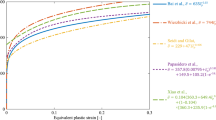Abstract
For extruded aluminum alloys, the identification of mechanical properties and the corresponding constitutive modeling are very challenging, due to the complex structured part geometry, microstructure variance, difficulty in performing standard testing, and discrepancy between material- and structural-scale deformation. With these challenges, in this study, the plasticity and ductile fracture models for an aluminum extrusion part having a complex cross-sectional shape are identified based on an inverse experimental–numerical approach. In particular, bending experiments in part-scale are employed as alternatives to standard mechanical tests. A single and double finite element model updating scheme are newly suggested and performed to predict plastic hardening behavior and ductile fracture criterion from measured load–displacement curves. To overcome the limited deformation history available at various stress states, a virtual (deformation) path generation method is proposed for calibrating the fracture model. The feasibility of the optimized constitutive models is evaluated through a number of trials with modifications in the optimization process, which are successfully validated through comparison with experiments on load–displacement curves and fracture initiations. Finally, it is confirmed that the proposed inverse identification approach can offer a computationally efficient method for constitutive modeling, with potential applications in various engineering fields.










Similar content being viewed by others
References
Y. Dong, C. Zhang, G. Zhao, Y. Guan, A. Gao, and W. Sun, Mater. Des. 92, 983 (2016).
C. Zhang, C. Wang, R. Guo, G. Zhao, L. Chen, W. Sun, and X. Wang, J. Alloys Compd. 773, 59 (2019).
L. Xu, D. Zhou, C. Xu, H. Zhang, W. Qu, P. Xie, and L. Li, Mater. Today Commun. 34, 105138 (2023).
M. Grediac, F. Pierront, S. Avrilt, and E. Toussaint, Strain 42, 233 (2006).
C. Kim, and M.G. Lee, Int. J. Solids Struct. 233, 111204 (2021).
Z. Wang, J.B. Estrada, E.M. Arruda, and K. Garikipati, J. Mech. Phys. Solids 153, 104474 (2021).
D. P. Nikolov, S. Srivastava, B.A. Abeid, U. M. Scheven, E. M. Arruda, K. Garikipati, and J. B. Estrada, Philos. Trans. R. Soc. A Math. Phys. Eng. Sci., 380, (2022).
K.T. Kavanagh, and R.W. Clough, Int. J. Solids Struct. 7, 11 (1971).
J. Kajberg, and G. Lindkvist, Int. J. Solids Struct. 41, 3439 (2004).
S. Belhabib, H. Haddadi, M. Gaspérini, and P. Vacher, Int. J. Mech. Sci. 50, 14 (2008).
T. Pottier, F. Toussaint, and P. Vacher, Eur. J. Mech. A/Solids 30, 373 (2011).
S. Cooreman, D. Lecompte, H. Sol, J. Vantomme, and D. Debruyne, Exp. Mech. 48, 421 (2008).
P.A. Prates, A.F.G. Pereira, N.A. Sakharova, M.C. Oliveira, and J.V. Fernandes, Adv. Mater. Sci. Eng. (2016).
T. He, L. Liu, and A. Makeev, Compos. Struct. 184, 337 (2018).
G. Liu, L. Wang, Y. Yi, L. Sun, L. Shi, H. Jiang, and S. Ma, J. Nucl. Mater. 509, 445 (2018).
V. Tvergaard, Int. J. Fract. 18, 237 (1982).
V. Tvergaard and A. Needleman, Acta Metall. 32, 157 (1984).
J. Lemaitre, J. Eng. Mater. Technol. 107, 83 (1985).
M. Cockcroft and D.J. Latham, J. Inst. Met. 96, 33 (1968).
J.R. Rice and D.M. Tracey, J. Mech. Phys. Solids 17, 201 (1969).
Y. Bai and T. Wierzbicki, Int. J. Fract. 161, 1 (2010).
T.B. Stoughton and J.W. Yoon, Int. J. Plast. 27, 440 (2011).
Y. Lou, H. Huh, S. Lim, and K. Pack, Int. J. Solids Struct. 49, 3605 (2012).
D. Mohr and S.J. Marcadet, Int. J. Solids Struct. 67–68, 40 (2015).
T. Belytschko, J.I. Lin, and T. Chen-Shyh, Comput. Methods Appl. Mech. Eng. 42, 225 (1984).
R.P.R. Cardoso, and J.W. Yoon, Comput. Methods Appl. Mech. Eng. 194, 1161 (2005).
K. Pack, T. Tancogne-Dejean, M.B. Gorji, and D. Mohr, Int. J. Solids Struct. 151, 214 (2018).
J.A. Nelder and R. Mead, Comput. J. 7, 308 (1965).
G. Gu and D. Mohr, Eng. Fract. Mech. 147, 480 (2015).
K. Pack and D. Mohr, Eng. Fract. Mech. 182, 32 (2017).
C.C. Roth and D. Mohr, Int. J. Plast. 56, 19 (2014).
S.J. Marcadet and D. Mohr, Int. J. Plast. 72, 21 (2015).
Y. Bai and T. Wierzbicki, Int. J. Plast. 24, 1071 (2008).
J. Lee, S.J. Kim, H. Park, H.J. Bong, and D. Kim, J. Mater. Process. Technol. 255, 584 (2018).
S. Basak, C. Kim, W. Jeong, Y. Il Jung, and M.G. Lee, Int. J. Mech. Sci. 219, (2022).
F.A. Potra and S.J. Wright, J. Comput. Appl. Math. 124, 281 (2000).
M. Dunand, A.P. Maertens, M. Luo, and D. Mohr, Int. J. Plast. 36, 34 (2012).
M. Luo, M. Dunand, and D. Mohr, Int. J. Plast. 32–33, 36 (2012).
Acknowledgements
This work has been supported by Hyundai Motors Group, which is greatly appreciated. The Institute of Engineering Research at Seoul National University provided research facilities for this work. M.G.L. appreciates the support by the National Research Foundation of Korea (NRF, Korea) (No. 2022R1A2C2009315) and the support by the Ministry of Trade, Industry & Energy (MOTIE, Korea) (1415185590, 20022438). J.Y.W. appreciates the support by the National Research Foundation of Korea (NRF, Korea) (No. 2021M3H4A6A01045764).
Author information
Authors and Affiliations
Corresponding author
Ethics declarations
Conflict of interest
The authors declare that they have no conflict of interest.
Additional information
Publisher's Note
Springer Nature remains neutral with regard to jurisdictional claims in published maps and institutional affiliations.
Rights and permissions
Springer Nature or its licensor (e.g. a society or other partner) holds exclusive rights to this article under a publishing agreement with the author(s) or other rightsholder(s); author self-archiving of the accepted manuscript version of this article is solely governed by the terms of such publishing agreement and applicable law.
About this article
Cite this article
Won, J.Y., Hong, S., Nam, B. et al. Identification of Plasticity and Fracture Models for Automotive Extruded Aluminum Parts Using Finite Element Model Updating Algorithm. JOM 75, 5479–5493 (2023). https://doi.org/10.1007/s11837-023-06164-z
Received:
Accepted:
Published:
Issue Date:
DOI: https://doi.org/10.1007/s11837-023-06164-z




